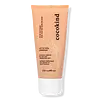What's inside
What's inside
 Key Ingredients
Key Ingredients

 Benefits
Benefits

 Concerns
Concerns

No concerns
 Ingredients Side-by-side
Ingredients Side-by-side

Water
Skin ConditioningCaprylic/Capric Triglyceride
MaskingPrunus Armeniaca Kernel Oil
MaskingVitis Vinifera Seed Oil
EmollientGlycerin
HumectantPropanediol
SolventCetearyl Ethylhexanoate
EmollientSimmondsia Chinensis Seed Oil
EmollientSodium Lauroyl Oat Amino Acids
CleansingCetearyl Olivate
Sorbitan Olivate
EmulsifyingAloe Barbadensis Leaf Juice
Skin ConditioningPhenoxyethanol
PreservativeXanthan Gum
EmulsifyingAcrylates/C10-30 Alkyl Acrylate Crosspolymer
Emulsion StabilisingSodium Gluconate
Skin ConditioningEthylhexylglycerin
Skin ConditioningTocopherol
AntioxidantSodium Hydroxide
BufferingCentella Asiatica Extract
CleansingPotassium Sorbate
PreservativeCitric Acid
BufferingSodium Benzoate
MaskingWater, Caprylic/Capric Triglyceride, Prunus Armeniaca Kernel Oil, Vitis Vinifera Seed Oil, Glycerin, Propanediol, Cetearyl Ethylhexanoate, Simmondsia Chinensis Seed Oil, Sodium Lauroyl Oat Amino Acids, Cetearyl Olivate, Sorbitan Olivate, Aloe Barbadensis Leaf Juice, Phenoxyethanol, Xanthan Gum, Acrylates/C10-30 Alkyl Acrylate Crosspolymer, Sodium Gluconate, Ethylhexylglycerin, Tocopherol, Sodium Hydroxide, Centella Asiatica Extract, Potassium Sorbate, Citric Acid, Sodium Benzoate
Helianthus Annuus Seed Oil
EmollientGlycerin
HumectantVitis Vinifera Seed Oil
EmollientWater
Skin ConditioningSucrose Laurate
EmollientAvena Sativa Kernel Oil
Skin ConditioningAdansonia Digitata Seed Oil
EmollientSucrose Stearate
EmollientTocopherol
AntioxidantPelargonium Graveolens Flower Oil
MaskingSucrose Palmitate
EmollientAnthemis Nobilis Flower Oil
MaskingAvena Sativa Kernel Extract
AbrasiveLactobacillus Ferment
Skin ConditioningHelianthus Annuus Seed Oil, Glycerin, Vitis Vinifera Seed Oil, Water, Sucrose Laurate, Avena Sativa Kernel Oil, Adansonia Digitata Seed Oil, Sucrose Stearate, Tocopherol, Pelargonium Graveolens Flower Oil, Sucrose Palmitate, Anthemis Nobilis Flower Oil, Avena Sativa Kernel Extract, Lactobacillus Ferment
 Reviews
Reviews

Ingredients Explained
These ingredients are found in both products.
Ingredients higher up in an ingredient list are typically present in a larger amount.
Glycerin is already naturally found in your skin. It helps moisturize and protect your skin.
A study from 2016 found glycerin to be more effective as a humectant than AHAs and hyaluronic acid.
As a humectant, it helps the skin stay hydrated by pulling moisture to your skin. The low molecular weight of glycerin allows it to pull moisture into the deeper layers of your skin.
Hydrated skin improves your skin barrier; Your skin barrier helps protect against irritants and bacteria.
Glycerin has also been found to have antimicrobial and antiviral properties. Due to these properties, glycerin is often used in wound and burn treatments.
In cosmetics, glycerin is usually derived from plants such as soybean or palm. However, it can also be sourced from animals, such as tallow or animal fat.
This ingredient is organic, colorless, odorless, and non-toxic.
Glycerin is the name for this ingredient in American English. British English uses Glycerol/Glycerine.
Learn more about GlycerinTocopherol (also known as Vitamin E) is a common antioxidant used to help protect the skin from free-radicals and strengthen the skin barrier. It's also fat soluble - this means our skin is great at absorbing it.
Vitamin E also helps keep your natural skin lipids healthy. Your lipid skin barrier naturally consists of lipids, ceramides, and fatty acids. Vitamin E offers extra protection for your skin’s lipid barrier, keeping your skin healthy and nourished.
Another benefit is a bit of UV protection. Vitamin E helps reduce the damage caused by UVB rays. (It should not replace your sunscreen). Combining it with Vitamin C can decrease sunburned cells and hyperpigmentation after UV exposure.
You might have noticed Vitamin E + C often paired together. This is because it is great at stabilizing Vitamin C. Using the two together helps increase the effectiveness of both ingredients.
There are often claims that Vitamin E can reduce/prevent scarring, but these claims haven't been confirmed by scientific research.
Learn more about TocopherolVitis Vinifera Seed Oil comes from the grape vine. Grape seeds are a byproduct of creating grape juice or wine.
The components of grape seeds have many skin benefits. Research has found it to be antimicrobial and anti-inflammatory. It also contains many potent antioxidants such as Vitamin E , Vitamin C, proanthocyanidins, polyphenols, flavonoids, and anthocyanins. Proanthocyanidin has been shown to help even out skin tone.
Antioxidants help fight free-radical molecules. Free-radical molecules are capable of damaging our cells and other genetic material. Antioxidants help stabilize free-radicals by donating extra electrons. Grape seed extract may help reduce the signs of aging.
The antimicrobial properties of grape seed may help treat acne. However, more research is needed to support this claim.
Grape seed has also been found to help absorb UV rays. Grape seed extract should not replace your sunscreen.
The fatty acids of grape seed oil give it emollient properties. Emollients help soothe and soften your skin by creating a film. This film traps moisture within, keeping your skin hydrated.
Learn more about Vitis Vinifera Seed OilWater. It's the most common cosmetic ingredient of all. You'll usually see it at the top of ingredient lists, meaning that it makes up the largest part of the product.
So why is it so popular? Water most often acts as a solvent - this means that it helps dissolve other ingredients into the formulation.
You'll also recognize water as that liquid we all need to stay alive. If you see this, drink a glass of water. Stay hydrated!
Learn more about Water